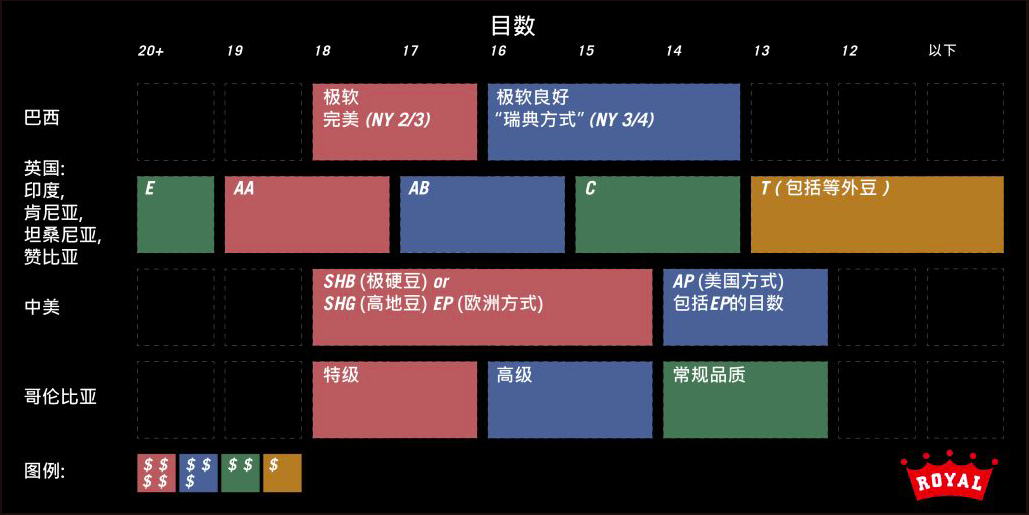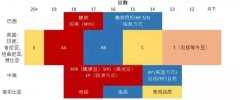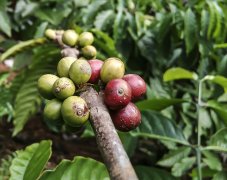Why should raw coffee beans be classified according to the number of items? The relationship between the size of coffee beans and the price
For professional baristas, please follow the coffee workshop (Wechat official account cafe_style)
The final step in a coffee drying plant is to make a final classification of raw coffee beans according to the number of items of coffee, and then bag them for export. The machine for classifying the number of coffee items is very large, divided into several layers, each tilting slightly downward. When the coffee enters the machine, the machine begins to vibrate, and the raw coffee beans with different mesh are screened out by gravity. The workers picked up the screened coffee beans in sacks at the bottom of the machine. Through multi-layer screening, the number of coffee beans selected is more accurate, and these devices can also be manually adjusted. I had the opportunity to disassemble and reassemble the machine with local workers in Zambia. But the parts he needed were out of stock, so we had to spend the whole afternoon adjusting to make sure the maximum number of holes was at the top.
In fact, this kind of machine is not very complicated, but a lot of metal parts are put together to remove debris from the coffee by vibration. But not really. When I visited Henrique Sloper, the owner of Camocim in Pedra Azul, Espirito Santo province, Brazil, I saw his coffee sorting equipment. You can see its exquisite organ-like design in the following picture.
Naming convention
Coffee beans measure the number of coffee eyes through the round holes of the sorting equipment. These round holes are usually measured in one-inch 1canap 64. The so-called 16-mesh coffee beans are 16cm 64 inches in diameter, or 1ax 4 inches in diameter. This is basically a global standard, some countries directly use the number of items to name beans, while others use some special names to correspond to the corresponding number of items.
Some former British colonies in East Africa (such as Kenya, Tanzania, Zambia, etc.) are used to distinguishing coffee by table names, including India, which use the so-called British classification system, using the letters A, B, C and T to classify coffee. In Colombia, the taxonomic names are Supremo and Excelso, while in Brazil, Fine Cup and N2Unip 3 are used. In Central America, EP (European way) is used, and few countries use AP (American way) to name the classification. In addition, SHB (extremely hard beans) and SHG (highland beans) are also used to mark the highest grade of coffee beans. In addition, high-quality coffee in Brazil is labeled SS (extremely soft) to indicate the taste of coffee (such as softer), as well as softer beans or lower elevations.
Each classification basically stipulates its own fault tolerance ratio, that is, the proportion of coffee beans that does not belong to this range. EP allows no more than 5 per cent of coffee beans under 15 mesh, while AP is more relaxed, up to 100 per cent and 13 mesh. The Colombian Coffee Growers Association once stipulated that 5 per cent of Excelso grade coffee is not allowed in 13-14 mesh, and the classification criteria were later revised to strictly stipulate that only 1.5 per cent of Excelso allowed less than 14 mesh.
It may be a bit confusing to discuss different definitions in this area, and to illustrate it more clearly, I made the following comparison table:

Is this classification really important?
All this information may eventually point to a key issue. Of course, this question really can not be generalized, there is no absolute yes or no answer. This method of classification based on the number of items depends on several factors; in the traditional understanding, the number of items of coffee will greatly affect roasting, from this point of view, the answer is yes. But looking at it from other angles, there are many exceptions. Let's take a closer look at:
Big means high price. Big means high price.
Globally, the size of coffee beans is directly related to the price of coffee beans; in many markets, the size of coffee beans is an important factor in determining prices. This is related to some traditional ideas that the larger the particles of beans, the higher the quality. For example, the price of a Kenyan AA is usually higher than that of a Kenyan AB. From the current understanding, this view may be a little out of date. But it is still used in many organizations, such as ITC (International Trade Center) and ICO (International Coffee Organization). As stated in the ICO literature, "using this classification based on the number of coffee orders, there is a certain basis that coffee beans at higher altitudes are denser, while beans with larger grains contain more substances, so they are of higher quality than beans at lower altitudes. Similarly, coffee at high altitude grows more slowly and therefore contains more flavor substances. "
Under these conditions, the smallest beans are generally screened out and sold as low-quality beans at a low price. In addition, very large beans (sometimes called elephant beans) are also screened out as low-quality coffee. However, there are exceptions, through this large bean has spawned a new variety, namely the Pacamara variety, more than 50% of the coffee beans are more than 19 orders.
In fact, this is not entirely true, and there will be exceptions. According to some studies, large coffee beans tend to grow at high elevations and in shade, while other studies claim that high-altitude coffee is smaller, more nutritious and denser. Such beans are higher-quality coffee. Interestingly, it is difficult to grow large coffee beans in many parts of the world, such as Narino in Colombia, southern Rwanda, and all over Ethiopia, where coffee beans are usually small particles.
Ethiopian coffee beans are recognized as the highest quality coffee in the world's boutique coffee field, but the coffee produced here is without exception small particles.
In our products, more than half of the coffee is 15 mesh or smaller, about 20% is 14 mesh or smaller, and about 36% is very small. According to the traditional grading standards in many countries, almost 1/4 of our coffee is disposed of and cannot be sold. But these coffees can get good results in the process of cup testing.
Some countries have changed their minds and turned the beans into an available advantage. In Tanzania, for example, round beans are sorted out and sold at higher prices. In coffee grading, the treatment of round beans is also very interesting, and it is often treated as small particles or defective beans. In fact, this is a phenomenon of genetic variation, that is, in coffee cherries that are supposed to produce two seeds, the cells do not divide and produce only one round seed. Some people say that the seed particles absorb more nutrients, so the flavor should be better, but this claim has not been confirmed by science. Others say that coffee beans of this shape will make coffee roasting more difficult if mixed with ordinary coffee beans. But in either case, round beans are valued by people. People have even made special equipment for screening round beans, and the screen used to screen round beans is oval rather than round.
PS: what is the size of coffee beans? It's the number of eyes.
But what is the number of eyes? How do you measure it? A lot of people don't understand.
Just let the numbers talk. First, let's take a look at the usual measurement methods in the coffee industry.
The industry describes the size of raw coffee beans as a unit of 64 inches, that is, 1 mesh.
The size of the international practice is between 9 and 22.
The score represents the diameter of the screen; the bean order is the molecule. If the bean order is large, the molecule is big; if the bean order is small, the molecule is small.
The big raw bean at 1:16 refers to the coffee raw bean that can pass through 17 inch 64 (inch) but get stuck in the 16 inch 64 (inch) diameter (diameter) sieve.
A large raw bean at 2:18 refers to a coffee raw bean that can pass through 19 inch 64 (inch) but get stuck in an 18 inch screen with a diameter (diameter) of 64 inch.
Converted to metric system, 17 eyes are 6.75mm, 18 eyes are 7mm, 19 eyes are 7.5mm. Do you know the size of raw beans more clearly?
Let's put aside the difficult math problems and take a look at the real world. Take Colombia, which attaches great importance to raw bean size as a coffee grade standard, as an example, the top coffee bean (that is, the largest raw bean) is Supremo, and the evaluation standard is 17-18 mesh size. [aroma] the imported giant elephant beans are 98% in size more than 20 mesh. In other words, Colombia is far better than Supremo.
Important Notice :
前街咖啡 FrontStreet Coffee has moved to new addredd:
FrontStreet Coffee Address: 315,Donghua East Road,GuangZhou
Tel:020 38364473
- Prev

Basic screening of raw beans: how to classify the grades of raw coffee beans by the screening system of raw coffee beans
Communication of professional baristas Please follow the coffee workshop (official Wechat account cafe_style) it is obviously unrealistic to sift coffee beans by hand and visually. The coffee screen is equivalent to a measuring tool, so the accuracy of selection is a very important part. Many countries use sieve systems to grade raw coffee beans. The principle behind it is actually: compared to its
- Next

What is the level of detail of raw coffee beans in Kenya? what are AB round beans?
Professional barista exchange please follow the coffee workshop (Wechat official account cafe_style) Kenya Pearl beans Top Sika producing area Honey Cooperative (Kenya PB Top Thika Asali Cooperative) flavor description: grapefruit, mulberry, caramel, candied-like sweet and sour taste, full and juicy, crisp and sweet. Production area: Sika production area (Thika) producer: honey cooperation
Related
- Detailed explanation of Jadeite planting Land in Panamanian Jadeite Manor introduction to the grading system of Jadeite competitive bidding, Red bid, Green bid and Rose Summer
- Story of Coffee planting in Brenka region of Costa Rica Stonehenge Manor anaerobic heavy honey treatment of flavor mouth
- What's on the barrel of Blue Mountain Coffee beans?
- Can American coffee also pull flowers? How to use hot American style to pull out a good-looking pattern?
- Can you make a cold extract with coffee beans? What is the right proportion for cold-extracted coffee formula?
- Indonesian PWN Gold Mandrine Coffee Origin Features Flavor How to Chong? Mandolin coffee is American.
- A brief introduction to the flavor characteristics of Brazilian yellow bourbon coffee beans
- What is the effect of different water quality on the flavor of cold-extracted coffee? What kind of water is best for brewing coffee?
- Why do you think of Rose Summer whenever you mention Panamanian coffee?
- Introduction to the characteristics of authentic blue mountain coffee bean producing areas? What is the CIB Coffee Authority in Jamaica?

